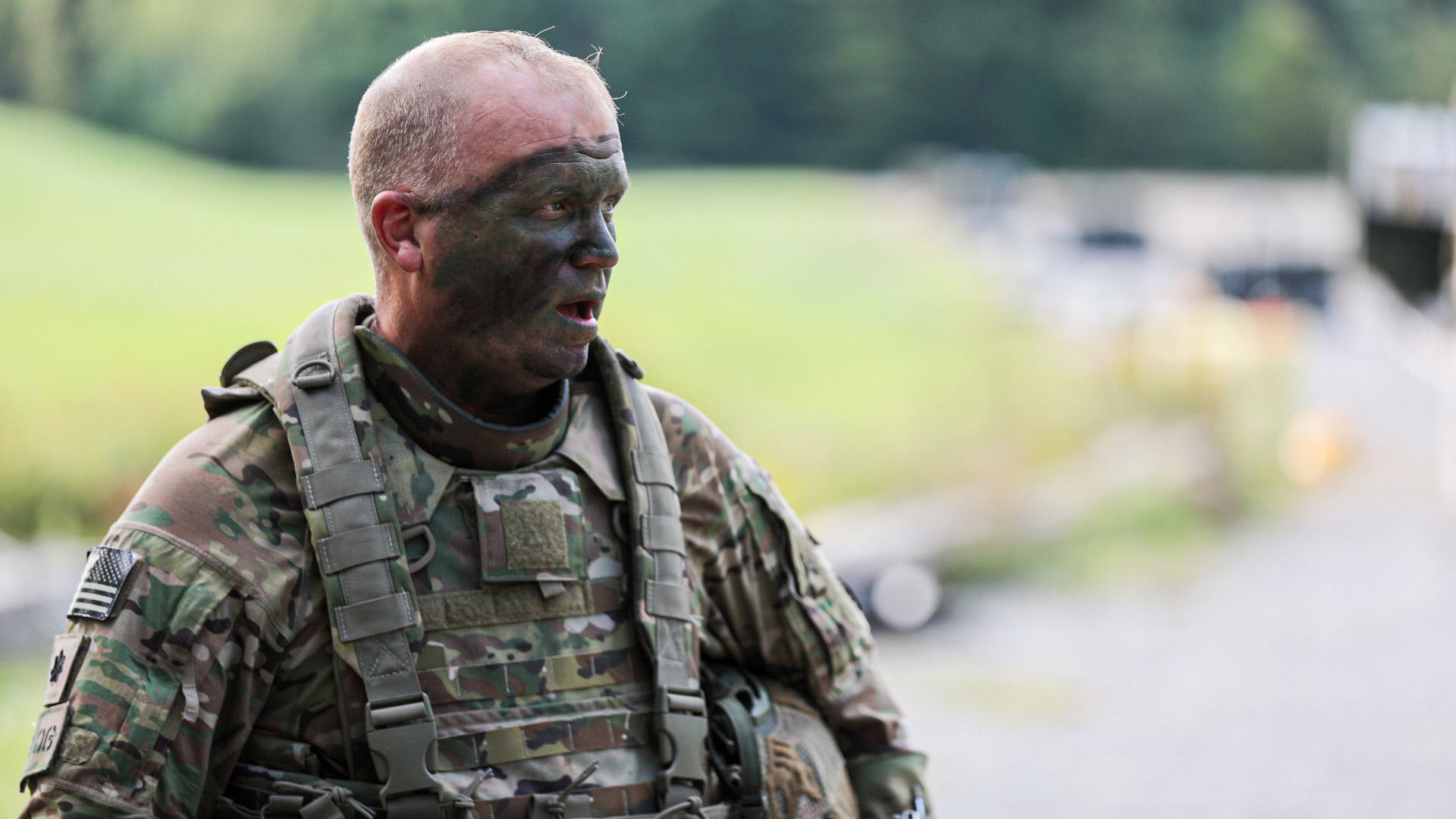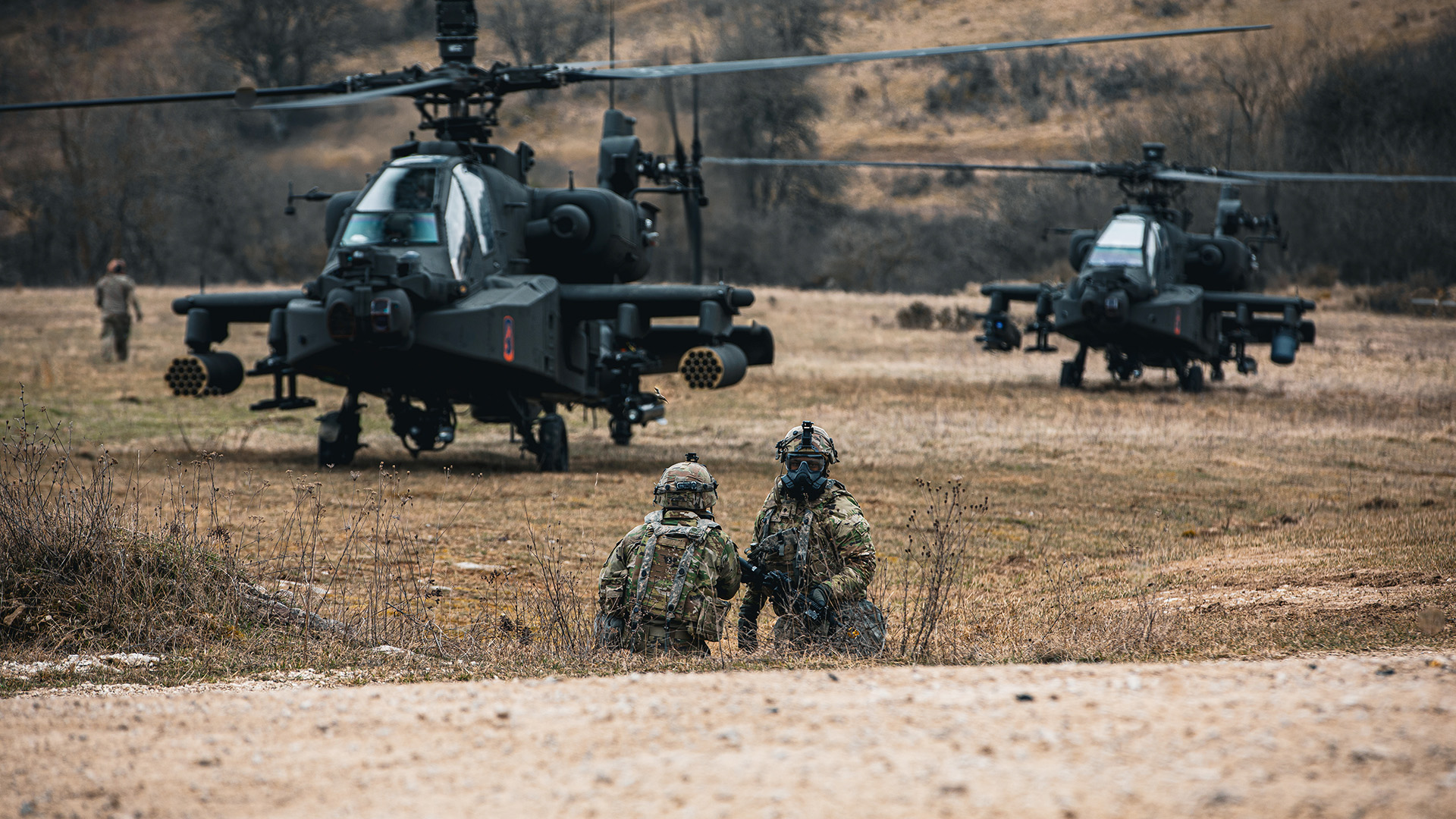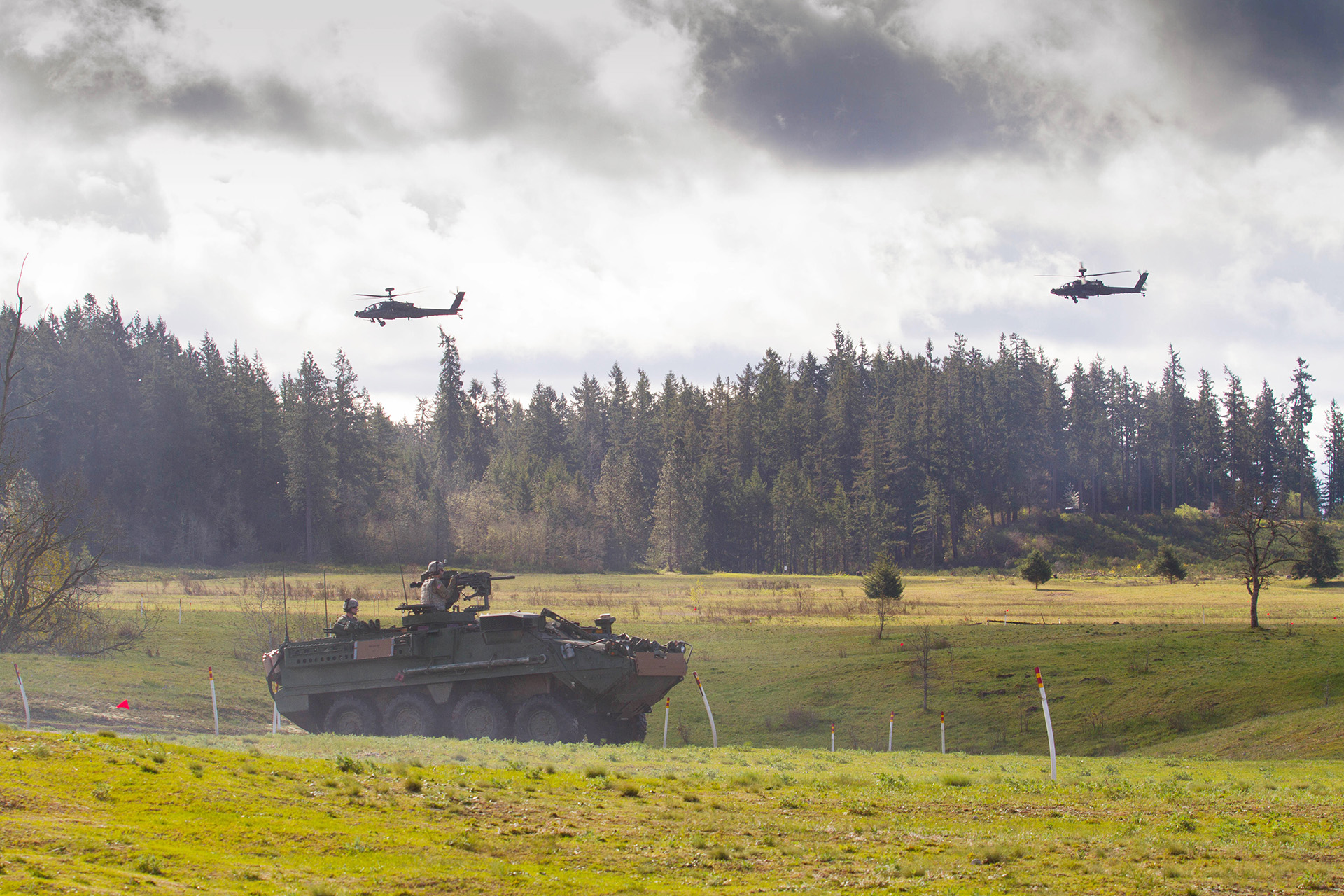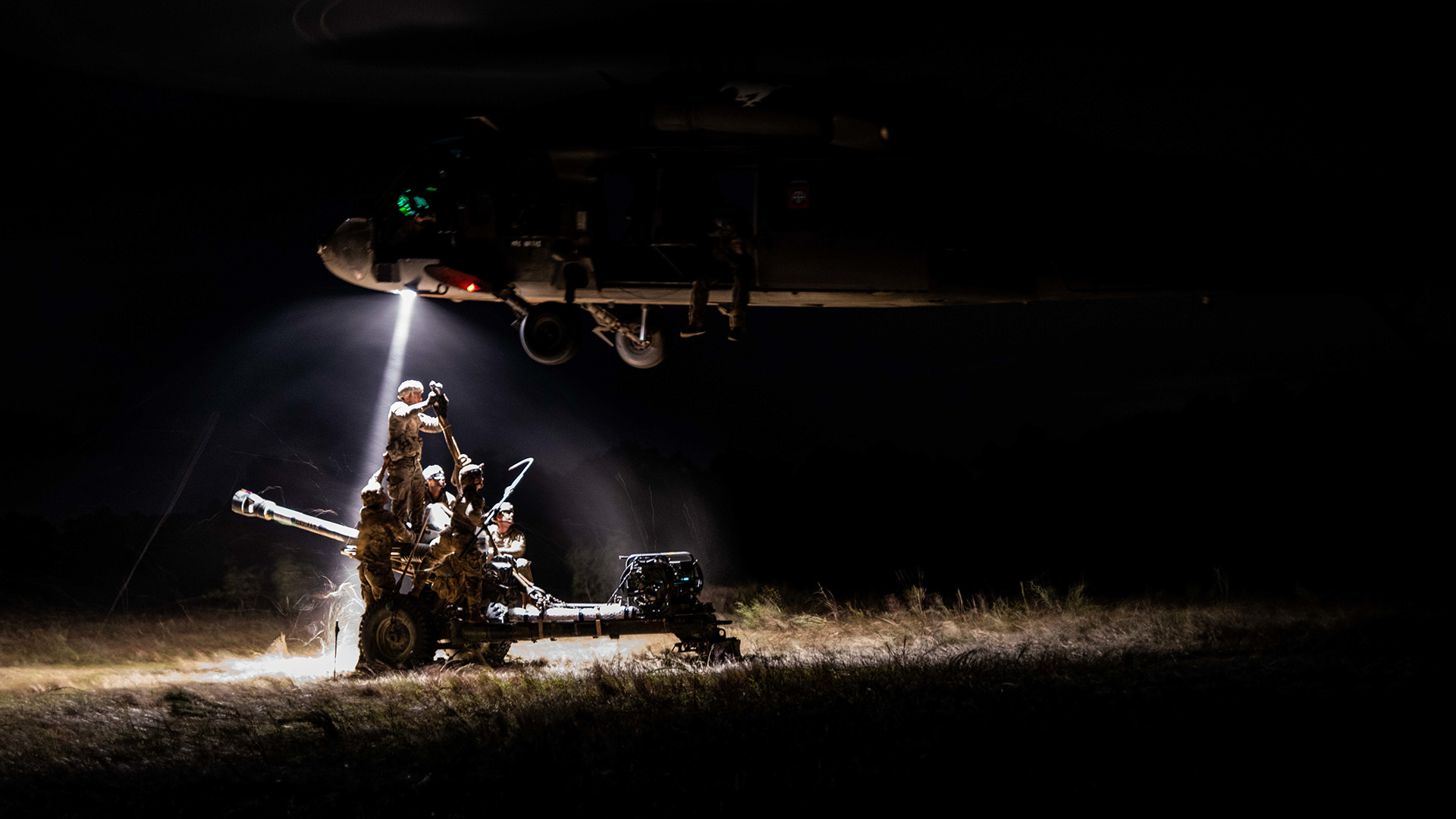Crafting an Aviation Warfighter Culture for the Future Fight
By MG Clair A. Gill
Article published on: May 1, 2025 in the Aviation Digest January-March 2025 Issue
Read Time: < 16 mins

LTC Keith Benoit wears camoufage face paint during an aerial gunnery near Fort Drum, New York. U.S. Army photo by SGT Jamie Robinson.
Introduction
Like the rest of our Army, the Aviation Branch finds itself transforming to prepare for a challenging future. Everything is evolving in response to potential threats, but our mission requirements continue without pause. And so, “Army Aviation stands ready to meet tomorrow’s challenges, today.” Coincidentally, that statement of preparedness was also the theme for this year’s Army Aviation Senior Leader Forum, or AVSLF, at Fort Novosel, Alabama.
The AVSLF is an opportunity for senior leaders across the Aviation Branch and Army to come together and discuss current challenges and opportunities for operations in the upper tier of the ground domain. Topics discussed at the AVSLF included readiness, experience, maneuver, maintenance, acquisitions, unmanned systems, and updates on current operational environment conditions and threats. Senior Leaders actively discussed these vital matters to ensure preparedness of our Aviation Soldiers today and in the future fight. Leaders often spoke of keeping pace with peer threats and even yet unforeseen enemies who are constantly pushing warfare at the pace of technology. A major point of focus centered around the culture and grit required to fight a war similar to that experienced by those in the Ukraine-Russia conflict. The activity level and sense of urgency was a call to action for all in attendance.
While technology was a key point of discussion at the AVSLF, there were other major areas of interest. We talked about all the factors that influence our collective readiness from personnel to maintenance to training, and I need you—the Soldiers and leaders of the Aviation Branch—to focus your attention on these critical aspects of our profession. As warfare evolves—and it is changing rapidly as evidenced on battlefields in Ukraine and other areas—so too must our organizational culture. Gone are the days of solely counterinsurgency operations (COIN); future Large-Scale Combat Operations (LSCO) will certainly be demanding in new ways. This is a critical moment for Aviation Soldiers everywhere to consider what we do well, areas for improvement, and use our time now to embrace a revised Aviation Warfighter Culture to ensure the preparedness for a complex future fight.
The Basics of Organizational Culture and a Call to Arms
A strong sense of culture, whether positive or negative, can have a significant impact upon an organization. Every organization has a culture, and whether known or unknown, everyone participates in that culture. In many ways, a culture represents the unwritten sense or feeling one has about an organization that is perceptible with nearly every interaction. A good definition for culture is “the set of values, norms, guiding beliefs, and understandings that is shared by members of an organization and taught to new members as the correct way to think” (Daft, 2010, p. 374).
Army branches, to include Army Aviation, are subordinate cultures that are important, but secondary, to the greater Army culture. No matter where you go in the Army, organizational culture rests in the hands of the unit leaders. That means the culture of our branch rests in the hands of Aviation leaders at every echelon. Tose hands, to include my own, all have a role in shaping and developing our branch culture. I take the state of Army Aviation’s culture very seriously, as it provides a sense of who we are as a branch. Our culture speaks of our shared values and beliefs as Aviation Soldiers and governs how we contribute to our Army mission. Internally, our branch culture contributes to our collective identity as members of our Army’s combined arms team. Externally, our branch culture influences how we achieve our assigned missions in both peace and combat. The two are inextricably linked. Our current organizational culture, both its internal and external linkage, has come across a dangerous sense of status quo as a byproduct of more than 20 years of COIN operations. Realized or not, COIN created a seismic shift in how we perceive our role in combat. During this period of our history, we flew high, avoided dangerous confrontations when able, and operated from the relative safe ty of the nearest forward operating base. The impact of Aviation Branch members became measured in view of the performance of lethal teams. In many ways, we became individuals with an eroded sense of purpose in light of the greater intended Army mission, flying above the fray and losing site of our role within the land domain of warfare. That’s not to say we weren’t valued contributors to tactical success—to be sure, we were.

U.S. Soldiers assigned to the 12th Combat Aviation Brigade provide security during Allied Spirit 25 at the Hohenfels Training Area, Joint Multinational Readiness Center, Germany. U.S. Army photo by SGT Christian Aquino.
However, around 2014, it became obvious that small unit tactics and reliance on lethal teams would not remain the recipe for future success. Russia shocked the world with its annexation of Crimea. By 2018, and in response to strategic aggression by Russia and China, the National Defense Strategy began to acknowledge the reality of “long-term strategic competition” with China and Russia (Department of Defense, 2018, pp. 2–4). The new and pressing threat had moved from non-state terrorists to peer and near-peer threats. In response to the shifting sands of the global operational environment, the Army began what is called a doctrinal pivot with the release of Field Manual (FM) 3-0, “Operations” (Department of the Army [DA], 2025). Large-Scale Combat Operations had become the new point of focus and have since morphed into multidomain operations, as peer and near-peer threats can now challenge forces across five different domains of warfare.
Our Army now requires an Aviation force that is optimally manned, and occasion ally even optionally manned, and able to deliver the necessary capabilities—as desired by the ground force commander—in a dynamic future fight that aids in achieving the seizure and retention of the enemy’s land, people, and resources. Our real future value to the Army aligns with the ability to allow a ground force commander to exercise their force as they see ft. And so, it becomes necessary that Aviation Branch culture pivot from an overemphasis on team tactics and individual proficiency to instead embrace the collective identity of units equipped and trained to effectively conduct LSCO. The value and success of the individual is obvious, but it should not trump the success and identity of the greater unit. It is time to redouble our Warfighter Culture.
Some might argue that we don’t need change; we just need to focus on the fundamentals—good point, but it doesn’t go far enough. To better prepare as a branch in service to the Army of the future, it is time to reorient away from what was once known as operations other than war (FM 100-5) and return to the original intent for keeping Aviation forces within the Army—organic Aviation support to enhance combat operations in the land domain. For the past few decades, and as dictated by operational needs, Army Aviation has performed every mission under the sun. However, a return to large-scale combat requires the branch to transform toward a necessary shared identity as Army Aviation Warfighters for eventual success in future LSCO. Yes, we need to be good at our fundamentals, but we need to advance on that to create a culture of warfighters who are good at the basics but know how to adapt to a more lethal environment. Less structure, less certainty, and less “rotational” mentality.

The 16th Combat Aviation Brigade participates in a combined arms life-fre exercise at Joint Base Lewis-McChord, Washington. U.S. Army photo by MAJ Brian Harris
Current Aviation Culture–Sustains
When I discuss culture with other Aviation leaders, I first ask what they like about our culture, or the things we organizationally emphasize and value that guide our professional identity. Tink about it–why did you choose our branch? It is important to start with sustains, because our heritage and unique identity as professionals is derived in large part from our sense of organizational culture. After all, certain hallmarks of our organizational culture have greatly contributed to our branch success. Some of the most valued aspects of our professional culture are often identified by leaders as individual expertise, independence, aircrew proficiency, and application of Aviation capability as part of the combined arms team.
Individual expertise is critical in Army Aviation; it’s the foundation on which we build our war-winning capability for our Army. Our branch requires highly intelligent and technically oriented Soldiers, capable of working on incredibly advanced systems, equipment, and in challenging environments. Lives are always on the line in Army Aviation, and leaders know it. LTG (Ret.) Walt Piatt often said that every day is a live fire in Army Aviation. As a result, Army Aviation has always emphasized and valued technical expertise, adherence to standards, and trust throughout each echelon. Additionally, the expertise and technical acumen of the individual Aviation Soldier has led to the development of a remarkable sense of independence. Our Soldiers make decisions every day that directly impact mission success. The branch consistently recognizes and values the decisiveness, critical thinking, and disciplined execution of our Aviation Soldiers. Each one of these prized and valued elements of our organizational culture needs to be taught, trained, and sustained. Our culture must also emphasize and value the elements of our branch that feed and orient our professional identity on meeting the needs of the ground force commander in the land domain during LSCO.
Current Aviation Culture–Areas for Growth
Large-scale combat in the future fight will be best met by Aviation Soldiers who focus and value things that decidedly support the ground force commander. After all, the “logic of land war–i.e., land forces operate to control territory, whether for their own end or in support of joint force objectives” dictates that success is measured on the ground (Fox, 2024, p. 8). By extension, any arm of the Army should understand its role and purpose through the lens of the logic of land war. And so, as our organizational attention is drawn to the challenges and complexities of LSCO and future warfare, I believe there are areas in our culture that are primed for growth and improvement.
If our collective purpose in Army Aviation is contributing to success for those on the ground, then areas for growth in organizational culture should begin with that desired outcome. Our understanding of being value added must extend beyond Aviation-centric success criteria. And so, Army Aviation must better understand ground force needs, operations, and tactics. If Army Aviation better understands ground warfare, our Soldiers can better support the missions of the ground force when in combat. This is not a new concept, as Army Aviation was first developed and sustained, beyond the 1947 birth of the Air Force, to ensure organic Aviation support to Army ground forces (Total Military Insight, 2024). Our reason for existing is success in the land domain, and as a branch, we should value and emphasize extensive knowledge of ground warfare.
As our branch embraces a deeper appreciation for ground warfare, there will be a necessary shift in our training and application of tactics and operations. An Aviation Branch that is focused on ground warfare, especially LSCO, will begin to push the envelope by consistently emphasizing collective training. Collective application of Army Aviation capabilities, and I mean those well beyond the company level, are tough to conduct and even harder to support. However, dynamic large-scale training today is necessary to equip the commanders of tomorrow with the skill sets and experiences that will inform their efforts in the future fight. Some units, particularly our Transformation in Contact units and those forward deployed, are beginning to train for LSCO. This is hard and requires in-depth planning and preparation; however, it also cultivates the idea that we need to build experience and proficiency now. Tomorrow is too late. We should all feel a sense of urgency and ownership to address it now.
A focus on ground doctrine, combined with audacious LSCO-oriented training, will begin to produce a visible difference in all Aviation Soldiers. These Aviation Soldiers will begin to get anxious to apply their skill set and knowledge in a mission setting and not simply fly traffic patterns or conduct cross-country fights. Aviation Soldiers who steer away from the overemphasis on individual performance and move instead to the application of their skill set alongside combined arms teammates in a mission setting, start to cultivate a warfighter identity. Everything will then become oriented on expressing the value of themselves to their greater unit and what they can do to fight and win in combat. If we as leaders measure value of our Soldiers by their contributions to unit success and performance in collective mission settings, we will begin to see and express our value as warfighting organizations. The Aviation Branch must better recognize our collective value to the ground force commander, educate our Soldiers according to success in the land domain, and train to develop the necessary capabilities to win in LSCO.
Improvements in the previously discussed areas are sure to begin to shape an Aviation Warfighter Culture. Still, I am certain there are some reading this article who potentially doubt the impact of a warfighting culture and its contribution to success in war. History is replete with examples of the impact of a culture on successful outcomes.
Foundations of a Warfighter Culture
In Steven Pressfeld’s 1998 book, Gates of Fire, he recounts the legendary story of the Spartan hoplites led by King Leonidas and their successful defense of the Hot Gates at the Battle of Thermopylae. During the battle, a mixed force of approximately 7,000 Greeks, to include a core of 300 Spartans, held of an invading force estimated to number between 120,000 to 300,000 Persian invaders for nearly 3 days. The defensive operation bought their fellow Greeks time to prepare for coming fights and forever emblazoned the significance of Spartan warfighting culture to the annals of history.

The 3D Brigade Combat Team engage in a combined arms live-fre exercise on Fort Bragg, North Carolina. U.S. Army photo by SSG Vincent Levelev.
The reverence for the Spartan namesake, while arguably overly popularized today, is a testament to their warfighting prowess, a byproduct of a culture ingrained in the agoge.1 In the movie adaptation 300, King Leonidas hammers home the idea of culture with his troops when he asks, “Spartans! What is your profession?” The brave 300 release a synchronized battle cry allowing Leonidas to state, “See, old friend, I brought more soldiers than you did” (Snyder, 2006). Teir professional identity was rock solid, and the foundation proved decisive in application.
As American Soldiers and Army Avia tors, we should take every bit of pride in OUR culture, and I am more than a little curious how Soldiers would describe it both internal and external to the branch. Furthermore, what would you or other Aviation Branch Soldiers say if asked, “what is your profession?” I believe a sense of profession is interwoven into our organizational culture.
A warfighter culture begins individually and is discovered through self-refection and asking hard questions. For instance, how have you committed yourself to our profession? A good indicator might be your practice of self-study, self-improvement, and whether you go the extra mile. What does the extra mile look like? Well, if you are scheduled to fly late, it should involve starting your day with vigorous PT. Going the extra mile might also be volunteering to take a new Soldier under your wing to demonstrate what right looks like. Is there accountability in your unit? Ask yourself if and how you are challenging your team, or tribe. Do you look like a warfighter? When the situation gets challenging or dynamic, do you throw the technical book at the problem and avoid conflict, or do you lean in and own the problem? These are tough points to consider and only answered by the Soldier in the mirror, but such is the nature of self-refection.
Now, if you joined our Army for the college benefits, that’s great. But at some point, you must commit to the profession and embrace this life of self-sacrifice for our cause. As GEN (Ret.) Martin Dempsey says in his book, No Time for Spectators, (2000), this is not a spectator sport. Our profession demands a level of commitment—you took that oath, at least once. It’s time to embrace our culture and renew your honor, each day. After all, commitment to our profession is one of the necessities.
General (Ret.) Douglas MacArthur explains this necessity best when he said, “Trough all this welter of change and development your mission remains fixed, determined, inviolable. It is to win our wars. Everything else in your professional career is but corollary to this vital dedication … you are the ones who are trained to fight. Yours is the profession of arms, the will to win, the sure knowledge that in war there is no substitute for victory” (MacArthur, 1962). To put it simply, our profession is war, and everyone in the branch must be committed to that profession through the application of their Aviation skills.
Closing Thoughts
Admittedly, organizational culture is a very big topic. I do not want anyone to consider our current culture in a negative light; after all, Army Aviation has served our nation and Army with distinction, decisively, for more than 7 decades. The reality remains that our future fight will be nothing like our past engagements. In response to the changes and complexities of modern warfare, it is necessary to change how we, as Aviation professionals, approach our current and future roles in war. Aviation Soldiers must remain disciplined, technical experts in all aspects of Aviation. However, Aviation Soldiers must grow in their tactical focus, exuding expertise in how the Army fights as a meaningful whole, thereby enhancing our collective worth as a combined arms teammate. I firmly believe that the Aviation Warfighter Culture is Army Aviation’s key to refining our collective professional identity, and it will live or die with all of you, the Soldiers of Army Aviation.
Notes
1. The “agoge” refers to a state-controlled educational and training system for male Spartan youth.
Authors
MG Clair Gill was commissioned in Army Aviation from the United States Military Academy at West Point in 1994. He has served with a variety of units, to include command in the 101st Aviation Regiment and 10th Combat Aviation Brigade. In 2021, MG Gill served as Director, Army Aviation on the Headquarters, DA staf for 1 year, followed by his most recent 2-year assignment as Deputy Director for Regional Operations and Force Management (J35) on the Joint Staf. MG Gill is now the commander of the U.S. Army Aviation Center of Excellence.